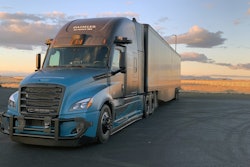Driver training and coaching methods have been more difficult to execute in 2020 amid a global health pandemic. Many fleets have limited their in-person interactions and ride-along evaluations with drivers in favor of remote training technology.
Fleet telematics and camera vision systems already were being used for remote driver training, but this year has accelerated their capabilities. Suppliers have added new advancements in sensors and artificial intelligence (AI) to not only help train drivers from a safe distance but also to move the transportation industry faster toward an autonomous future.
Samsara has three new features for its AI Dash Cam that help fleets with remotely coaching, training, and engaging drivers.
- Mask Detection uses artificial intelligence to automatically detect if a driver is not wearing a mask when he or she enters the cab at the beginning of a trip or after exiting the vehicle and returning.
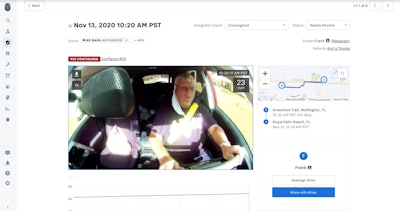 Samsara’s AI Dash Cam detects whether or not a driver is wearing a mask.
Samsara’s AI Dash Cam detects whether or not a driver is wearing a mask.Samsara says the Mask Detection feature is mainly for fleets that need to monitor compliance of mask wearing for drivers who work in pairs such as ambulance, construction or bus drivers. It has optional in-cab alerts for drivers and can auto-upload footage for safety managers.
“This is a great way to help provide and promote a culture of mask wearing for driver health and safety,” said Ingo Wiegand, director of product management, Samsara.
The new feature joins other AI-detected events and behaviors from Samsara for tailgating and distracted driving.
- Live Streaming: Safety managers can perform virtual ride-alongs by accessing live video of vehicles on the road.
Live Streaming allows safety managers to conduct virtual ride-alongs to onboard new drivers. Road-facing video and inward-facing video can be streamed in real time to the Samsara dashboard. The feature gives drivers in-cab alerts to notify them when a live stream starts and ends.
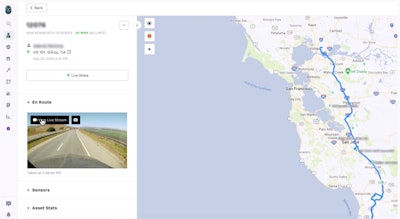 Safety managers can have a real-time view of drivers for training.
Safety managers can have a real-time view of drivers for training.Robert Ackerman, safety director of SeniorCare EMS, the largest commercial ambulance service in New York City, is using Live Streaming to give instantaneous feedback to drivers.
“As an emergency service, we do random audits of crews driving on emergency calls to ensure that both the lights and sirens are activated and that the crews are coming to a complete stop at all intersections — keeping the ambulance, crew, and public safe,” he said.
- Driver Video Share: Safety managers can now share event videos directly with drivers, enabling remote and self-guided coaching.
Safety managers can share event videos directly with drivers, who will receive a text notification with a link to the event details and video.
Removing the guesswork
Nearly half of the drivers that Veriha Trucking hires come to the company from CDL schools.
“As a training fleet, safety is our number one value — that’s what we’re focused on,” said Karen Smerchek, president of the Marinette, Wisconsin-based truckload carrier. In 2013 the company installed a camera system to remove guesswork from safety.
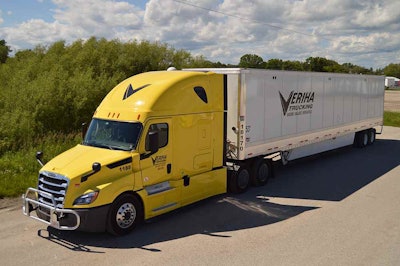 Veriha Trucking is using a camera system from Netradyne that helps drivers self-coach by using a mobile app.
Veriha Trucking is using a camera system from Netradyne that helps drivers self-coach by using a mobile app.“Cameras really tell us how to proceed,” she said. “I feel like the stress of people within my safety team has decreased so much because they don’t carry the burden of deciding what happened. They get to take action based on what they have visibility to, and they get to see the truth through that camera.”
Drawn to the system’s artificial intelligence (AI) and edge computing that detects, reasons and determines the causality of critical safety events, Veriha switched to Netradyne’s Driveri safety camera system for its 250-truck fleet in 2018.
Veriha now gives drivers a daily scorecard for self-coaching. Drivers use a mobile app from Netradyne, and their scores include positive recognition for defensive driving and other good behaviors, as well as identifying areas for improvement.
“Getting the data into a usable format for your drivers to see truly does wonders,” Smerchek noted. “Even though we don’t have a bonus [attached to the score], there are groups of friends challenging each other to improve.”
Driver managers are using real-time alerts and reports through a web portal to determine if drivers are embracing self-coaching or have recurring issues that will need additional support.
Netradyne has a new smaller version of the Driveri system that it claims will support any class of commercial vehicle. Like the original version, the new Driveri D-210 has dual inward and outward cameras that support HD video recording and real-time event playback.
Driving to autonomy
Fleets are also using new advancements in camera technology to alert managers and drivers to complex risky behaviors such as distraction and fatigue. This new wave of risk detection and self-coaching is also moving the transportation industry closer to self-driving technology.
Vehicles equipped with lane keeping and adaptive cruise technology prompt drivers to maintain control of the steering wheel despite having the capability to pilot themselves for extended periods in traffic.
Driver-facing cameras and AI are the bridge leading commercial vehicles to greater levels of autonomy.
As a fleet telematics provider, Zenduit has sensors and a live dash camera that detects risky driving behaviors such as phone use, smoking, distraction and fatigue. The camera platform is available for use with telematics platforms from Geotab and others.
Zenduit’s camera technology could be used by a vehicle with autonomous capabilities to determine if the driver is attentive and ready to take control of a vehicle, if needed, said company President Vishal Singh. The company currently is focused on collecting data that shows where drivers become fatigued or distracted, and how they interacted with vehicles when certain type of incidents occurred.
The company is sharing this type of data with governments and university researchers to help build greater confidence in autonomous driving technology, which will require systems that can measure driver behaviors (such as attentiveness) and integrate this status into the vehicle’s steering, throttle and brake controls, Singh said.
Remote training and inspections
Telematics and fleet management software provider IntelliShift, which has more than 2,600 customers managing 100,000 connected assets, has new offerings for its platform that assist with remote driver training and coaching.
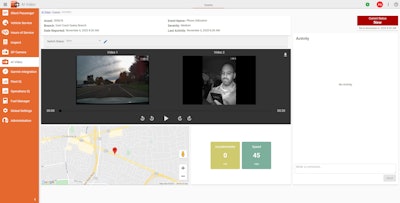 IntelliShift’s new AI Video can detect a range of risky driver behaviors, including distractions like texting.
IntelliShift’s new AI Video can detect a range of risky driver behaviors, including distractions like texting.The first is Operations IQ, which uses a cloud-based data warehouse from Snowflake that gives users the ability to create multi-dimensional reports, visualizations and dashboards from connected datasets that include telematics, fuel usage and spend, safety, vehicle service, inspections and more.
The tool is not limited to telematics, video and other data collected by the IntelliShift platform, said Ryan Wilkinson, IntelliShift chief technology officer.
The second is AI Video. As the name suggests, it is an in-cab safety video system that goes beyond using accelerometer and ECM-based data to trigger event recordings. The system uses artificial intelligence (AI), G-force sensors and 360-degree video to give alerts, and 20-second video clips, for unsafe driving behaviors and hazardous road conditions for coaching.
The product is able to detect risky behaviors associated with distracted driving, driver fatigue, phone usage and smoking. AI Video also gives alerts to drivers for lane departure and unsafe following distance. By tapping into the truck’s turn signals, the system offers drivers an audio or visual notification if they depart their lane without signaling.
Finally, the company has added more features to its mobile driver vehicle inspection report (DVIR) tool, IntelliShift Inspect. To help ensure drivers are walking around the vehicle to do an inspection, the application can force a live photo to be taken for any item, such as a turn signal.
Users can also customize inspection forms for drivers to do temperature checks, cab sanitation, job site inspections and more. Going forward, IntelliShift plans to apply machine learning and AI to deliver confidence scores for each inspection using accelerometer and GPS data.
IntelliShift was founded as Vehicle Tracking Solutions in 2002 and focused on small and medium businesses. In 2018 it changed its name after expanding its telematics to include systems for the truck and trailer to serve large fleets with more than 500 vehicles.




